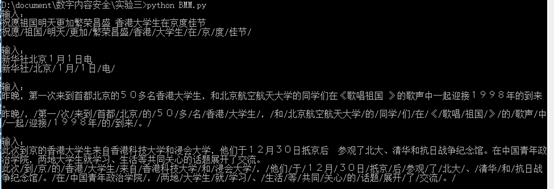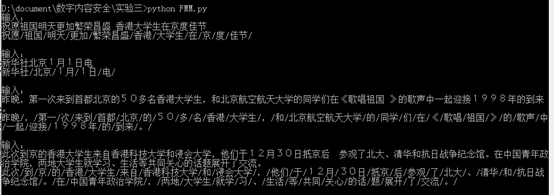FMM和BMM的python代码实现
FMM和BMM的python代码实现
-
FMM和BMM的编程实现,其实两个算法思路都挺简单,一个是从前取最大词长度的小分句,查找字典是否有该词,若无则分句去掉最后面一个字,再次查找,直至分句变成单词或者在字典中找到,并将其去除,然后重复上述步骤。BMM则是从后取分句,字典中不存在则分句最前去掉一个字,也是重复类似的步骤。
-
readCorpus.py
import sys output = {} with open('语料库.txt', mode='r', encoding='UTF-8') as f: for line in f.readlines(): if line is not None: # 去除每行的换行符 t_line = line.strip('\n') # 按空格分开每个词 words = t_line.split(' ') for word in words: # 按/分开标记和词 t_word = word.split('/') # 左方括号去除 tf_word = t_word[0].split('[') if len(tf_word) == 2: f_word = tf_word[1] else: f_word = t_word[0] # 若在输出字典中,则value+1 if f_word in output.keys(): output[f_word] = output[f_word]+1 # 不在输出字典中则新建 else: output[f_word] = 1 big_word1 = t_line.split('[') for i in range(1, len(big_word1)): big_word2 = big_word1[i].split(']')[0] words = big_word2.split(' ') big_word = "" for word in words: # 按/分开标记和词 t_word = word.split('/') big_word = big_word + t_word[0] # 若在输出字典中,则value+1 if big_word in output.keys(): output[big_word] = output[big_word]+1 # 不在输出字典中则新建 else: output[big_word] = 1 f.close() with open('output.txt', mode='w', encoding='UTF-8') as f: while output: minNum = sys.maxsize minName = "" for key, values in output.items(): if values < minNum: minNum = values minName = key f.write(minName+": "+str(minNum)+"\n") del output[minName] f.close() -
BMM.py
MAX_WORD = 19 word_list = [] ans_word = [] with open('output.txt', mode='r', encoding='UTF-8')as f: for line in f.readlines(): if line is not None: word = line.split(':') word_list.append(word[0]) f.close() #num = input("输入句子个数:") #for i in range(int(num)): while True: ans_word = [] try: origin_sentence = input("输入:\n") while len(origin_sentence) != 0: len_word = MAX_WORD while len_word > 0: # 从后读取最大词长度的数据,若该数据在字典中,则存入数组,并将其去除 if origin_sentence[-len_word:] in word_list: ans_word.append(origin_sentence[-len_word:]) len_sentence = len(origin_sentence) origin_sentence = origin_sentence[0:len_sentence-len_word] break # 不在词典中,则从后取词长度-1 else: len_word = len_word - 1 # 单词直接存入数组 if len_word == 0: if origin_sentence[-1:] != ' ': ans_word.append(origin_sentence[-1:]) len_sentence = len(origin_sentence) origin_sentence = origin_sentence[0:len_sentence - 1] for j in range(len(ans_word)-1, -1, -1): print(ans_word[j] + '/', end='') print('\n') except (KeyboardInterrupt, EOFError): break -
FMM.py
MAX_WORD = 19 word_list = [] with open('output.txt', mode='r', encoding='UTF-8')as f: for line in f.readlines(): if line is not None: word = line.split(':') word_list.append(word[0]) f.close() #num = input("输入句子个数:") #for i in range(int(num)): while True: try: origin_sentence = input("输入:\n") while len(origin_sentence) != 0: len_word = MAX_WORD while len_word > 0: # 读取前最大词长度数据,在数组中则输出,并将其去除 if origin_sentence[0:len_word] in word_list: print(origin_sentence[0:len_word]+'/', end='') origin_sentence = origin_sentence[len_word:] break # 不在字典中,则读取长度-1 else: len_word = len_word - 1 # 为0则表示为单词,输出 if len_word == 0: if origin_sentence[0] != ' ': print(origin_sentence[0]+'/', end='') origin_sentence = origin_sentence[1:] print('\n') except (KeyboardInterrupt, EOFError): break -
效果图
- BMM.py(不含大粒度分词)

- BMM.py(含大粒度分词)

- FMM.py(不含大粒度分词)

- FMM.py(含大粒度分词)

我们可以观察到含大粒度分词的情况将香港科技大学,北京航空航天大学等表意能力强的词分在了一起而不是拆开,更符合分词要求。




